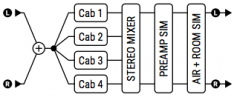yyz67
Fractal Fanatic
Every week or more often a user has an issue with "losing stereo" in a preset. This is almost always due to a block that sums to mono (also 2290 delay effect can be lost if there is a mono block downstream).
For example the Amp block and Cab block (by default) sum to mono:


WISH: Indicate if a block has stereo or mono ins/out via something like (both on unit and in AE).
For example, dots on either side of blocks ("jacks") could indicate number of effective in/out pass-through channels:

Yeah, it's not perfect as some blocks like Drive have a mix that could be set less than 100% (default) allowing stereo pass-through. And in the other direction, most stereo blocks with mix set to 100% (e.g. as in a parallel chain) sum to mono but usually there is a dry (stereo pass-through) shunt in this case.
I might attempt another version that indicates mix as a factor.
For example the Amp block and Cab block (by default) sum to mono:


WISH: Indicate if a block has stereo or mono ins/out via something like (both on unit and in AE).
For example, dots on either side of blocks ("jacks") could indicate number of effective in/out pass-through channels:

Yeah, it's not perfect as some blocks like Drive have a mix that could be set less than 100% (default) allowing stereo pass-through. And in the other direction, most stereo blocks with mix set to 100% (e.g. as in a parallel chain) sum to mono but usually there is a dry (stereo pass-through) shunt in this case.
I might attempt another version that indicates mix as a factor.
Last edited:
